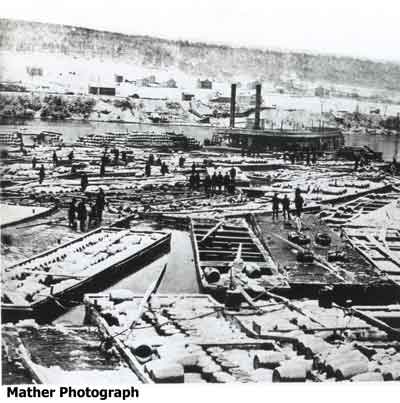 |
||||||
Observations, Wooden Oil Barrels
Saltwater is invariably present in crude oil to noticeable percentages, especially in the early days when it couldn't be properly separated in the field. If there was much saltwater it would dissolve the glue that lined the barrels and cause leakage (Williamson and Daum, 1959). Hopefully the oil would not be stored in the barrel too long.
Another problem had to do with the initial boiling point of crude oil which was lower than that of refined illuminants. This low boiling point allowed barreled crude to sometimes develop enough pressure to explode the barrel and burn (Williamson and Daum, 1959).
Coopering machinery was sometimes put to use at the neglect of kiln drying. "This speeded output of unseasoned staves" at the expense of quality (Williamson & Daum, 1959). Such practices led to the green barrel which was the worst type of new container.
It must have been a terrible hardship to be a producer in the face of the dire scarcity of barrels and the herculean task of getting them to the depot or wharf by wagon or raft in those earliest years. The producer-operator undertook excessive "miner's risk" and lived and worked in an agitated and constantly changing oilfield. The lucky ones surmounted the many obstacles only to be barrel-bound and dependent on the whip-snapping teamsters to cart the output on its first step to market. This describes the first five years of the 1860's in Oil Creek Valley. Some simple bulk boats were in use early on, but relief began to come by bulk transport in the second half of that oil-famous decade, still it was slow for these pumped-up oilmen. Beginning in 1865, but more so in the 1870's, pipelines and railway tank cars finally carried a lot of oil to market in bulk. The wooden oil barrel was on its way out.
 |
Flat boats loaded with wooden barrels of oil at the mouth of Oil Creek and the Allegheny River, Oil City, Pa., 1864. The flat boats had completed a perilous run down Oil Creek. The oil barrels were then transhipped on barges towed by steamboats to Pittsburgh. Some barges in the photograph are already loaded with four or more tiers of barrels. A boarded-over bulk boat (three men standing on it) would have either discharged its crude into barrels for the barge traffic or would float downstream to Pittsburgh on its own. |
![]()
| © 2004, Samuel T. Pees all rights reserved |
|